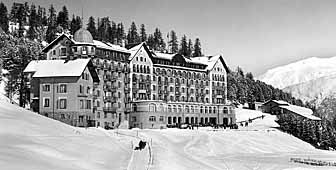Society ensures traditional buildings remain integral part of Swiss landscape

For over 300 years, the hostelry provided travellers crossing the Alps in southern Switzerland with overnight shelter. It became as much part of the landscape as the mountain peaks towering above the Rheinwald valley in canton Graubünden.
But the hotel Weisseskreuz in the village of Splügen fell into disrepair and lay abandoned for several years. If it had not been for Switzerland’s National Heritage Society, a landmark might have disappeared forever.
The society put forward plans to breathe new life into the building, restoring the hotel to its former glory, giving it up-to-date touches to appeal to today’s tourist, but retaining the charm and character of a bygone era.
The society is one of the main organisations ensuring that Switzerland’s wealth of tourist attractions and important sites are protected from the onslaught of developers and planners. Its mandate is to protect buildings it feels are important to maintain Switzerland’s cultural heritage.
Founded in 1905, it currently has around 18,000 members and is active in all 26 cantons. It is partly state funded, and by law it has the right of intervention to stop a building being pulled down. It can also have a say on how new buildings are designed.
Philipp Maurer, the director at the central office in Zurich, says without the society’s work, a lot of important buildings would vanish, or be destroyed. “Our work is crucial,” he says. “There are lots of examples where we have been able to give an owner an idea of a new way in which to use a building, which might otherwise have fallen into disrepair.”
Zurich architect Beate Schnitter says it is the constant loss of smaller buildings which poses the biggest threat to Switzerland’s heritage. “The danger comes not from the state, which recognises the need to preserve old buildings, but from private individuals who either want to make a large profit or who want to avoid the expense of maintaining properties they own.”
In the Italian-speaking canton of Ticino, the society helped rescue the Dazio Grande toll house on the southern side of the Gotthard pass, which for hundreds of years had been a resting point where travellers would change horses before resuming their journey. It directly overlooks a gorge and was completely renovated two years ago, adding a small restaurant and a few rooms.
The society’s current project is to save another hotel in Graubünden, the Chantarella. The owner, Credit Suisse, and the local authorities want to demolish the building, which feasibility studies show has no future as a hotel. The society agrees with the study, but maintains the 1910 building, which was designed by the Lucerne architect Emil Vogt, is a vital part of Swiss tourism history.
The society wants to convert the building into private apartments, which it says would be a much more interesting alternative to losing part of the region’s architectural heritage.
Every year the society awards a number of prizes in recognition of work done to preserve buildings and enrich the local environment. This year’s prestigious Wakker prize has been given to the city of Geneva for its redevelopment along the banks of the Rhone river, which Schnitter says, has revitalised the whole area.
In May it awarded the annual Swiss national heritage prize to a cultural organisation in the Viamala gorge area of Graubünden. The society said the “Viamala Association” had made the area more accessible to the public by restoring an old mule trail and inaugurating an open-air museum.
One more prize to be awarded on September 16 will be presented to a Swiss city for its work in cultivating its gardens and parks. The winner’s identity is still under wraps.
The society is also sponsoring Switzerland’s participation in European Heritage Day, one week earlier on September 10. For one day only, buildings throughout Switzerland, which are normally off limits to the public, will be throwing their doors open to the curious visitor.
by Jonathan Summerton

In compliance with the JTI standards
More: SWI swissinfo.ch certified by the Journalism Trust Initiative
You can find an overview of ongoing debates with our journalists here. Please join us!
If you want to start a conversation about a topic raised in this article or want to report factual errors, email us at english@swissinfo.ch.